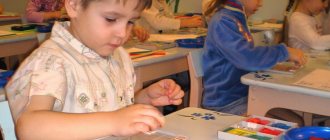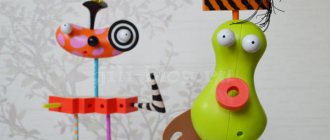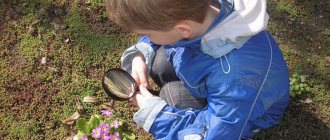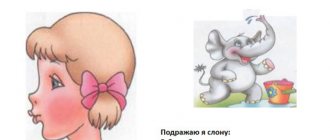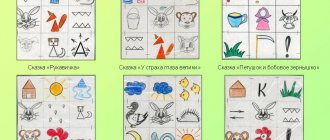Physical development
Height and weight of children 5 years old
| Boys | Girls |
| Height (cm) | |
| 110,0 | 109,4 |
| Weight, kg) | |
| 18,3 | 18,2 |
These indicators are averaged, depend on many reasons and may differ from one child to another.
1.1 Motor development
Movement is a natural need for children. Five-year-olds actively and with pleasure master physical exercises. They are hardy and capable of long walks. Their movements are coordinated, they love to run. This age is most favorable for starting classes in sports clubs, ballet and dance studios.
The cardiovascular and respiratory systems are being rebuilt. They begin to function more economically, which allows you to increase muscle loads. The ability to perform physical exercise increases to 25 minutes.
1.2 Self-care skills
By the age of five, basic self-care skills (hygiene, dressing, etc.) have been formed. The child must do them on his own initiative. He can help other guys fasten the button on the back, Velcro on their shoes.
Content:
- Age characteristics at 5-6 years old Differences between girls and boys
- Mathematics
- Games
Physical development
By the age of 3, the baby realizes whether he is a boy or a girl. And between the ages of 4 and 7 years, gender stability is formed.
The development of boys and the development of girls differ significantly. Psychological and pedagogical observations show differences in the characteristics of thinking, speech, and behavior. In girls, the left hemisphere, which is responsible for abstract and logical thinking, develops more intensively. In boys, it is the right one, coordinating spatial-figurative representations.
In thinking:
| Girls | Boys |
| – think more accurately and holistically; – more specific; - suggestible; - meticulous in detail; – set out in detail; – are subjective in their assessments of what happened; – everything unknown causes caution; – when performing a task, they require a clearly defined goal and specification. | – see the essence; – make generalizations; – love search activities and everything new, unknown; – almost no attention is paid to the quality of execution; – unfamiliar situations are perceived positively; – love variety; poorly organized. |
Speech:
| Girls | Boys |
| – has a subject-evaluative nature; – filled with nouns, adjectives, negatives and affirmations. | – filled with verbs and interjections; – generalizations are used. |
In applying the norms of behavior:
.
| Girls | Boys |
| – are happy to obey generally accepted rules; – like to imitate adults who are authoritative for them; – like to take on the role of mentors; – quickly adapt to a new environment. | – do not adhere to authorities; – transform everything around them; – are reluctant to comply with rules and norms of behavior, since they interfere with transformative activities. |
How to help your child develop: ideas and tips
During this period, children are constantly learning, so it is important to introduce them to new sports, crafts and social situations.
Here are some tips to help parents develop the necessary skills in their child:
- invite him to play more often, developing skills such as caring, responsiveness, the ability to share something with others, etc.;
- sing songs and read stories that develop empathy;
- Involve your child in household chores: cooking, cleaning, laundry, etc. These daily chores will help him develop motor skills and responsibility;
- Draw more together and do crafts. This will not only help with the development of fine motor skills, but will also tell you a lot about your child;
- Spend active time outdoors: ride a bike/scooter, swim, play with a ball, etc.
How to quickly and easily teach a child to ride a bike?
Games
In the world of gadgets, even popular children's games have lost their relevance. But in vain! We invite you to remember some of them and play with your children.
Active games on the street
- Bouncers
You will need at least 3 people and a ball. Two bouncers throw a ball to each other, trying to knock out the one in the middle.
Try a game of dodgeball in your yard or at the park and you will see how other kids will immediately want to join you.
2. Classics
The game is not only fun, but also develops coordination. And you can play it anywhere: both on the ground and on the asphalt.
Games for a group of children
For noisy children, you can offer a relay race game - this will help direct the children’s activity in the right direction.
Relay tasks:
- walking on tiptoes;
- walking with a balloon or ball without touching it with your hands;
- walking with a book on your head;
- pass under an obstacle (for example, stretch a ribbon between two chairs).
Draw a story
Make up a story and draw it on paper.
Think through the details down to the smallest detail, for example: “On the edge of the forest stood a house with a red roof and a brick chimney. The walls of the house..." Add heroes and you will be surprised by your child's imagination.
Box games
If you have at least one cardboard box in your house, you are guaranteed an entertaining evening. Girls can build a house for dolls from large boxes (or several small ones): paste wallpaper, make windows, arrange furniture. For boys, you can make a knight's castle, a garage with a descent or a service station.
Create a fairy tale
This game is good to play with the whole family. Its essence is to compose a fairy tale, when each participant speaks one sentence. A funny fable and a pleasant pastime are guaranteed to you.
5 years is an amazing age when you can suddenly find next to you not a baby, but a completely adult person, with his own taste and opinion. And if by the age of 3-4 it became easier for you in terms of caring for your child, then by this age it becomes noticeably easier to communicate with your son or daughter.
You already understand the child better, you can go to the cinema or museums together, travel, discuss what you see and just have fun. Enjoy the moment and each other’s company before school days begin and new worries arise!
Cognitive activity. What should a five year old child be able to do?
3.1 In the area “The world around us”
Knows:
- your first and last name, address, names of parents, their professions, name of your city, village;
- the name of the capital of your homeland, the main attractions of your city;
- about the importance of sun, air and water for life;
- types of transport, household appliances, some tools.
Can:
- determine the material - paper, fabric, wood, metal, plastic;
- make generalizations (a chair, a closet is furniture; a dress, socks are clothes).
3.2 In the field of elementary mathematics:
By the age of five the child has learned:
- compare the number of items in groups of up to 5 based on counting using the app and overlay;
- distinguish between circle, square, rectangle, triangle;
- group objects by color, size, shape;
- understand the meaning of words denoting parts of the day and define them;
- name the seasons, their signs, sequence.
What you should learn.
Form concepts:
- about ordinal (first) and cardinal (one) numbers up to 10;
- about what a quadrilateral is (a square and a rectangle are quadrilaterals);
- about another geometric figure - an oval.
Learn to:
- equalize two groups of objects (+1 and -1);
- count a given number of items (up to 10) from a large quantity;
- get acquainted with numbers from 1 to 9;
- understand how to make the number 5 from ones;
- relate volumetric (ball) and planar (circle) figures;
- lay out objects by length (from short to long), by height (from low to high), by width (from narrow to wide);
- compare objects by eye in terms of height, width, volume;
- check comparison by overlay and application;
- navigate the concepts of “yesterday”, “today”, “tomorrow”, as well as “first”, “then”;
- name the seasons, parts of the day, days of the week.
In the area of elementary mathematical concepts, we recommend “Tangram”, puzzles, sorters, simple puzzles, games with numbers up to 5, various “Confusions” (Which number is missing?), making patterns from geometric shapes, “Say the opposite” (narrow stream, river wide), “Find the odd one out” and others.
ATTENTION! Until the child reaches 7 years of age, play activity is leading. Therefore, there is no need to tell the child: “Let’s go study.” We need to encourage him to go play. Excessive didacticism can kill a child’s desire and desire for schooling.
3.3 In the field of speech development
By the age of five, the child fully masters coherent speech. Unfortunately, there is currently a large percentage of children with speech disorders.
ATTENTION PARENTS! The sound aspect of speech is an important indicator for further school education. If a child at the age of 5 misses or replaces sounds, “swallows” words, and cannot construct a grammatically correct sentence, he should urgently contact a speech therapist. You can't pull!
The nervous system of a preschooler is in the formative stage. Neural connections are formed in the cerebral cortex that reinforce sound pronunciation. It is necessary to correct speech pathologies while the nervous system is labile and capable of change. Upon reaching 7 years of age, correcting speech deficiencies will be much more difficult; correction will take much longer.
The Five Year Plan can:
- name your favorite literary works and the names of some authors;
- tell a short story without changing the sequence of the plot;
- memorize and expressively recite a short poem of 8 lines or more;
- play roles in the dramatization of familiar fairy tales and poems;
- compose a consistent story based on a plot picture, a series of pictures;
- compose short descriptive stories (“Winter fun”, “How Santa Claus lost his gifts”);
- retell familiar stories and fairy tales in detail;
- determine the place of a sound in a word;
- compare words by duration;
- identify a word with a given sound by ear;
- take part in conversations with peers or adults;
- express your point of view (agree or disagree);
- uses all parts of speech in conversation;
- selects adjectives for a given noun;
- finds synonyms for a given word (beautiful - wonderful).
There are many different entertaining games for speech development. Of these we can recommend:
- “Pick up a question - who? or what? to determine living and nonliving;
- “Guess the animal by its feature” (white, small, fluffy - it’s a hare);
- “Order in the apartment” based on the correspondence of an object to its place;
- “Letter to Grandma” - compiling a coherent story;
- “Vegetable garden” – classification of fruits, vegetables and berries according to species;
- “Choose beautiful words” - choose adjectives for the noun “apple” - red, round, tasty, healthy;
- “Journey to the ABC” - getting to know the letters.
The development of coherent speech is impossible without reading and discussing children's literary works. The most popular are folk tales. Five-year-olds are able to understand humor in literature. An example is the stories of N. Nosov.
We recommend reading the works of E. Uspensky, “The Letter “You” and other stories by L. Panteleev, “The Engine from Romashkovo” by G. Tsyferov, “Little Brownie Kuzka” by T. Alexandrov, “Tryam, Hello!” S. Kozlova, “Sipsik” Eno Raud.
You can read one chapter from “thick” books every day. These are “The Wizard of the Emerald City” by A. Volkov, “The Adventures of Cipollino” by J. Rodari, “The Golden Key or the Adventures of Pinocchio” by A. Tolstoy, “The Little Humpbacked Horse” by P. Ershov, “The Tale of the Kid and Carlson” by A. Lindgren.
Parents can enroll their five-year-old son or daughter in the children's library. The interest and love for literature that a child develops at this age will not fade away. The book will remain the baby's best friend.
Top 8 Android Apps
SagoMini Trains
The app will take your child on an exciting train ride through one of three locations - a city, a magical forest or a winter fairy tale. Along the way, the driver needs to pick up cargo and passengers. This is a great option for a long journey, since the game does not require an Internet connection.
Animal doctor
The application is a high-quality simulator of the work of a veterinarian. During the game, the child will learn to take care of pets and learn how to help a pet during illness. The app has nice animations and contains a lot of interesting information about health and hygiene, presented in simple language.
Fixies: Masters on a helicopter!
Favorite characters will help your child solve many interesting puzzles that develop logical thinking, memory, and the ability to synthesize and analyze information. The child’s task is to quickly fix various breakdowns throughout the city, and this is where a helicopter is needed.
Learning to Read in English. Preschool education
The application is built on the principles laid down by Maria Montessori. It is based on a plot about animals bewitched by an evil sorceress who need to be saved. The words are voiced by native speakers, thanks to which the child will hear the letter exactly as it sounds in a particular word. The game has 16 levels of varying difficulty. Training goes from simple to complex.
Dinobum
The application includes 20 educational puzzles of varying complexity to develop logic and thinking. Compare dinosaur figures, assemble puzzles, find a suitable shadow - these and other tasks will help your child learn to classify and organize objects according to different criteria.
Socialization
At the age of five, the child takes part in general games with pleasure and is able to take on a role. Children who are leaders themselves organize games with their peers.
Children are familiar with the norms of behavior in society and in nature. They can give a moral assessment of their actions and the actions of other people. Five-year-olds use words denoting emotional states (cheerful, sad, joyful, angry, angry). Children are able to determine what is considered beautiful and what is ugly.
Children respond emotionally to what is happening in books and cartoons; they are able to understand and evaluate the hidden motives of the actions of the characters.
Five-year-olds strive to provide all possible help around the house, which adults cannot refuse, so as not to discourage this desire.
ADVICE FOR PARENTS. Household chores that can be entrusted to a five-year-old owner:
- assemble the bed;
- cleaning the apartment as much as possible (putting your things and toys in their places);
- payment for small purchases;
- pet care (feeding and cleaning);
- assistance in setting the table;
- assistance in putting clean linen into the closet;
- watering house plants;
- the ability to prepare a simple breakfast from cereal or cottage cheese.
What else is important in raising a school-age child?
As a parent you are always learning. It's normal to feel confident in your knowledge. It's also okay to admit that you don't know something and ask questions or get help.
It's important to note that when you focus on caring for your baby, you may forget or fail to take care of yourself. But taking care of yourself physically, mentally and emotionally will help your child grow and develop.
Sometimes you may feel disappointed, upset or depressed. And it's okay to take a break until you feel better.
Visual activities
Drawing, modeling, applique are the favorite activities of preschoolers.
At this age, children are able to perceive works of high art. You should visit real or virtual museums and exhibitions, discussing what you saw with your child. Children should be introduced to the arts. These are visual activities (painting, graphics, sculpture), decorative and constructive (architecture and design).
The subjects of the little painter’s creations are varied. This is your favorite city, nature at different times of the year, illustrations for your favorite works, portraits, still lifes, space and more.
A young artist can:
- think about the plot and title of your drawing;
- use paints, crayons, felt-tip pens, pencils;
- use color to convey mood;
- convey the shape and color of objects in a drawing;
- compositionally place the main thing in the center of the image, the secondary - along the edges;
- mix colors;
- sculpt using plasticine, salt dough, clay, wet sand;
- construct from paper, fabric, natural and waste materials;
- Follow safety rules when using scissors.
Psychology of a five-year-old or how to raise a happy preschooler
At 5 years old, children understand much more than we think. Another thing is how the child reacts: discusses what he saw with his parents or draws his own conclusions. It is important to have a trusting relationship with your child.
The child's psyche cannot tolerate physical and harsh punishment. Insults will cause just as much harm. At 5 years old, a child is able to listen to an adult and analyze his mistake with him.
During this period, it is very important not to give long lectures to children and try to prohibit as little as possible. Offer an alternative. For example, you can’t hit a ball against walls at home, but you can hit it on the street. Or: you can’t draw on wallpaper, but you can on a sheet of paper.
Be sure to spend time with your child every day . Even if it’s just 15 minutes after work in the evening, it’s just your time without gadgets and the rest of your household.
Musical creativity
Music evokes an emotional response in every child. The favorite classical works of five-year-olds to listen to are plays from the “Children's Album” and the album “Seasons” by P.I. Tchaikovsky, folk songs.
Children happily sing accessible songs, dance to musical accompaniment, can combine dance movements with singing, and are able to convey the character of musical sound with their voice and movement. They are familiar with the concepts: “loud – quiet”, “fast – slow”, “sad – happy”.
Five-year-olds play children's musical instruments - rattles, xylophones, metallophones, drums. You can introduce your child to the concept of “orchestra” and its sound. A vivid illustration of the conversation about the orchestra will be the work “Peter and the Wolf” by S. Prokofiev.
Daily regime
Children 5 years old are recommended to take a 2-hour nap during the day. Developmental classes should be given 1.5 hours (3 lessons of 25 minutes each with breaks).
| 8:00-8:15 | awakening, hygiene procedures |
| 8:15-8:45 | morning work-out |
| 8:45-9:15 | breakfast |
| 9:15-10:30 | developmental activities |
| 10:30-12:00 | walk |
| 12:00-12:30 | preparing for lunch |
| 12:30-13:00 | dinner |
| 13:00-15:00 | dream |
| 15:00-15:30 | getting up, dressing, hygiene procedures |
| 15:30-16:00 | games, communication with adults |
| 16:00-16:30 | afternoon tea |
| 16:30-18:30 | walk |
| 18:30-19:00 | games, communication with adults, helping mom as much as possible, watching cartoons |
| 19:00-19:30 | dinner |
| 19:30-20:30 | communication with adults, reading books, games |
| 20:30-21:30 | water procedures, preparation for bed |
| 21:30-8:00 | night sleep |
Emotions and social skills
5 years is a period of emotional extremes. Either you notice that your child has better control over himself, then suddenly he begins to “play” at being little and seems completely helpless.
During this time, children learn to control their emotions, although they may burst into tears over an overturned glass of water. It is important to teach your child to understand his feelings and cope with them. At the same time, “coping” does not mean suppressing negative emotions.
A five-year-old child can already consciously sympathize with another or share his problems with someone.
Check how well your son or daughter's emotional and social development complies with generally accepted norms:
- periodically the child tries to please people;
- can distinguish reality from fantasy;
- may be more independent;
- realizes that society has its own rules that must be followed;
Your child can become more sociable if he starts going to kindergarten and meets more children.
Nutrition
The diet for five-year-olds is four meals a day. Smoked foods, fatty, spicy and fried foods, and natural coffee are prohibited.
Sample menu for 3 days
Monday
Breakfast: oatmeal porridge with milk, tea, wheat bread with butter and cheese.
Lunch : fresh cucumber salad, pea soup, boiled chicken, mashed potatoes, cranberry jelly, rye bread.
Afternoon snack : cottage cheese casserole with jam, milk.
Dinner : boiled fish with rice; tea, bread, fruit.
Tuesday
Breakfast : omelet, tea, bread with butter, cheese.
Lunch : carrot salad, borscht, fish cutlet with boiled potatoes, fruit drink, bread.
Afternoon snack : pie with jam, milk.
Dinner : stuffed zucchini, tea, bread with butter.
Wednesday
Breakfast : semolina porridge, cocoa, bread with butter, cheese.
Lunch : vegetable soup, meatballs with rice and green peas, compote, bread.
Afternoon snack : cheesecake, milk.
Dinner : potato zrazy with gravy, tea, bread, fruit.
